Junyi Wang
Coarse-to-Fine Joint Registration of MR and Ultrasound Images via Imaging Style Transfer
Aug 07, 2025Abstract:We developed a pipeline for registering pre-surgery Magnetic Resonance (MR) images and post-resection Ultrasound (US) images. Our approach leverages unpaired style transfer using 3D CycleGAN to generate synthetic T1 images, thereby enhancing registration performance. Additionally, our registration process employs both affine and local deformable transformations for a coarse-to-fine registration. The results demonstrate that our approach improves the consistency between MR and US image pairs in most cases.
Prototype-Driven Structure Synergy Network for Remote Sensing Images Segmentation
Aug 06, 2025Abstract:In the semantic segmentation of remote sensing images, acquiring complete ground objects is critical for achieving precise analysis. However, this task is severely hindered by two major challenges: high intra-class variance and high inter-class similarity. Traditional methods often yield incomplete segmentation results due to their inability to effectively unify class representations and distinguish between similar features. Even emerging class-guided approaches are limited by coarse class prototype representations and a neglect of target structural information. Therefore, this paper proposes a Prototype-Driven Structure Synergy Network (PDSSNet). The design of this network is based on a core concept, a complete ground object is jointly defined by its invariant class semantics and its variant spatial structure. To implement this, we have designed three key modules. First, the Adaptive Prototype Extraction Module (APEM) ensures semantic accuracy from the source by encoding the ground truth to extract unbiased class prototypes. Subsequently, the designed Semantic-Structure Coordination Module (SSCM) follows a hierarchical semantics-first, structure-second principle. This involves first establishing a global semantic cognition, then leveraging structural information to constrain and refine the semantic representation, thereby ensuring the integrity of class information. Finally, the Channel Similarity Adjustment Module (CSAM) employs a dynamic step-size adjustment mechanism to focus on discriminative features between classes. Extensive experiments demonstrate that PDSSNet outperforms state-of-the-art methods. The source code is available at https://github.com/wangjunyi-1/PDSSNet.
A Survey of Slow Thinking-based Reasoning LLMs using Reinforced Learning and Inference-time Scaling Law
May 05, 2025Abstract:This survey explores recent advancements in reasoning large language models (LLMs) designed to mimic "slow thinking" - a reasoning process inspired by human cognition, as described in Kahneman's Thinking, Fast and Slow. These models, like OpenAI's o1, focus on scaling computational resources dynamically during complex tasks, such as math reasoning, visual reasoning, medical diagnosis, and multi-agent debates. We present the development of reasoning LLMs and list their key technologies. By synthesizing over 100 studies, it charts a path toward LLMs that combine human-like deep thinking with scalable efficiency for reasoning. The review breaks down methods into three categories: (1) test-time scaling dynamically adjusts computation based on task complexity via search and sampling, dynamic verification; (2) reinforced learning refines decision-making through iterative improvement leveraging policy networks, reward models, and self-evolution strategies; and (3) slow-thinking frameworks (e.g., long CoT, hierarchical processes) that structure problem-solving with manageable steps. The survey highlights the challenges and further directions of this domain. Understanding and advancing the reasoning abilities of LLMs is crucial for unlocking their full potential in real-world applications, from scientific discovery to decision support systems.
A Novel Streamline-based diffusion MRI Tractography Registration Method with Probabilistic Keypoint Detection
Mar 04, 2025


Abstract:Registration of diffusion MRI tractography is an essential step for analyzing group similarities and variations in the brain's white matter (WM). Streamline-based registration approaches can leverage the 3D geometric information of fiber pathways to enable spatial alignment after registration. Existing methods usually rely on the optimization of the spatial distances to identify the optimal transformation. However, such methods overlook point connectivity patterns within the streamline itself, limiting their ability to identify anatomical correspondences across tractography datasets. In this work, we propose a novel unsupervised approach using deep learning to perform streamline-based dMRI tractography registration. The overall idea is to identify corresponding keypoint pairs across subjects for spatial alignment of tractography datasets. We model tractography as point clouds to leverage the graph connectivity along streamlines. We propose a novel keypoint detection method for streamlines, framed as a probabilistic classification task to identify anatomically consistent correspondences across unstructured streamline sets. In the experiments, we compare several existing methods and show highly effective and efficient tractography registration performance.
EndoChat: Grounded Multimodal Large Language Model for Endoscopic Surgery
Jan 20, 2025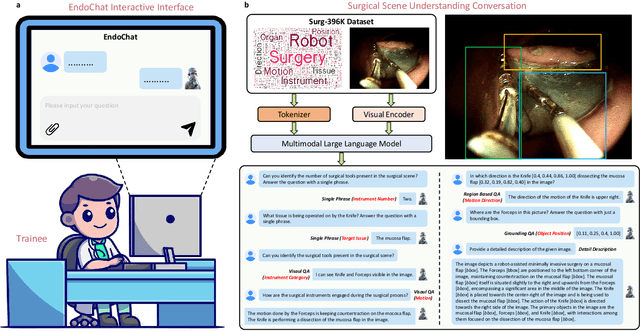

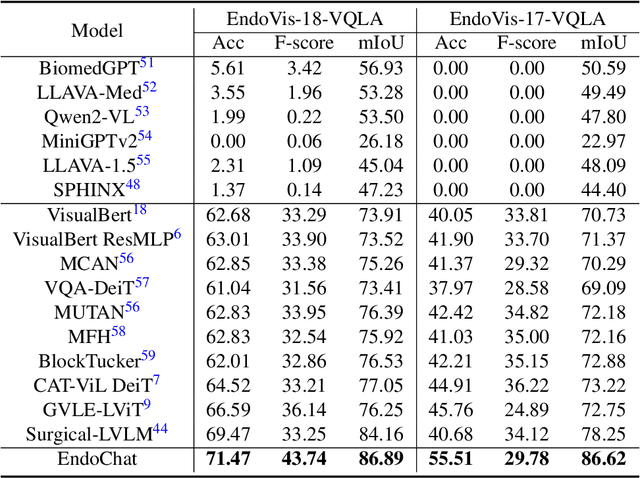
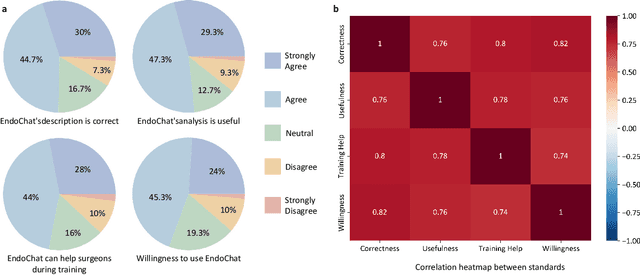
Abstract:Recently, Multimodal Large Language Models (MLLMs) have demonstrated their immense potential in computer-aided diagnosis and decision-making. In the context of robotic-assisted surgery, MLLMs can serve as effective tools for surgical training and guidance. However, there is still a lack of MLLMs specialized for surgical scene understanding in clinical applications. In this work, we introduce EndoChat to address various dialogue paradigms and subtasks in surgical scene understanding that surgeons encounter. To train our EndoChat, we construct the Surg-396K dataset through a novel pipeline that systematically extracts surgical information and generates structured annotations based on collected large-scale endoscopic surgery datasets. Furthermore, we introduce a multi-scale visual token interaction mechanism and a visual contrast-based reasoning mechanism to enhance the model's representation learning and reasoning capabilities. Our model achieves state-of-the-art performance across five dialogue paradigms and eight surgical scene understanding tasks. Additionally, we conduct evaluations with professional surgeons, most of whom provide positive feedback on collaborating with EndoChat. Overall, these results demonstrate that our EndoChat has great potential to significantly advance training and automation in robotic-assisted surgery.
SurgSora: Decoupled RGBD-Flow Diffusion Model for Controllable Surgical Video Generation
Dec 18, 2024Abstract:Medical video generation has transformative potential for enhancing surgical understanding and pathology insights through precise and controllable visual representations. However, current models face limitations in controllability and authenticity. To bridge this gap, we propose SurgSora, a motion-controllable surgical video generation framework that uses a single input frame and user-controllable motion cues. SurgSora consists of three key modules: the Dual Semantic Injector (DSI), which extracts object-relevant RGB and depth features from the input frame and integrates them with segmentation cues to capture detailed spatial features of complex anatomical structures; the Decoupled Flow Mapper (DFM), which fuses optical flow with semantic-RGB-D features at multiple scales to enhance temporal understanding and object spatial dynamics; and the Trajectory Controller (TC), which allows users to specify motion directions and estimates sparse optical flow, guiding the video generation process. The fused features are used as conditions for a frozen Stable Diffusion model to produce realistic, temporally coherent surgical videos. Extensive evaluations demonstrate that SurgSora outperforms state-of-the-art methods in controllability and authenticity, showing its potential to advance surgical video generation for medical education, training, and research.
Robust UAV Jittering and Task Scheduling in Mobile Edge Computing with Data Compression
Dec 18, 2024Abstract:Data compression technology is able to reduce data size, which can be applied to lower the cost of task offloading in mobile edge computing (MEC). This paper addresses the practical challenges for robust trajectory and scheduling optimization based on data compression in the unmanned aerial vehicle (UAV)-assisted MEC, aiming to minimize the sum energy cost of terminal users while maintaining robust performance during UAV flight. Considering the non-convexity of the problem and the dynamic nature of the scenario, the optimization problem is reformulated as a Markov decision process. Then, a randomized ensembled double Q-learning (REDQ) algorithm is adopted to solve the issue. The algorithm allows for higher feasible update-to-data ratio, enabling more effective learning from observed data. The simulation results show that the proposed scheme effectively reduces the energy consumption while ensuring flight robustness. Compared to the PPO and A2C algorithms, energy consumption is reduced by approximately $21.9\%$ and $35.4\%$, respectively. This method demonstrates significant advantages in complex environments and holds great potential for practical applications.
A Novel Deep Learning Tractography Fiber Clustering Framework for Functionally Consistent White Matter Parcellation Using Multimodal Diffusion MRI and Functional MRI
Nov 04, 2024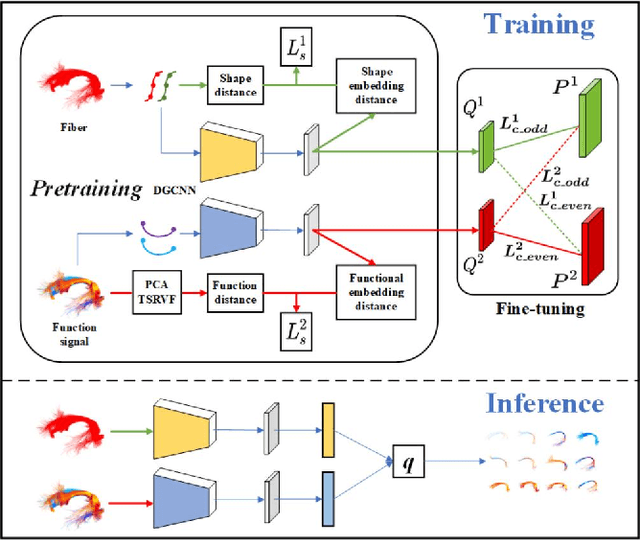
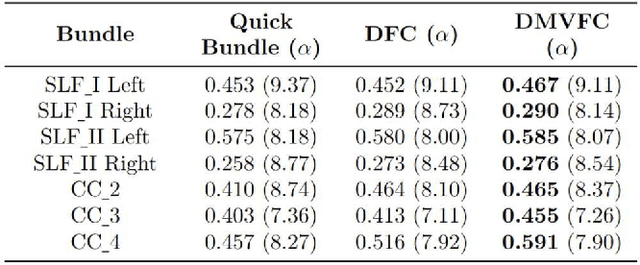
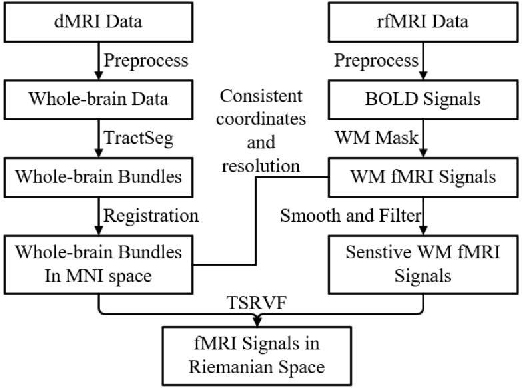
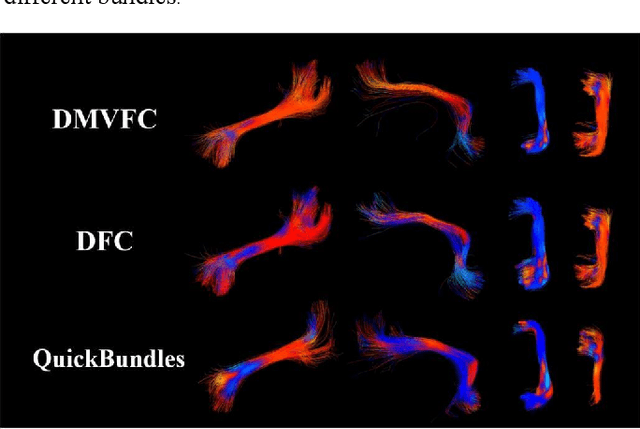
Abstract:Tractography fiber clustering using diffusion MRI (dMRI) is a crucial strategy for white matter (WM) parcellation. Current methods primarily use the geometric information of fibers (i.e., the spatial trajectories) to group similar fibers into clusters, overlooking the important functional signals present along the fiber tracts. There is increasing evidence that neural activity in the WM can be measured using functional MRI (fMRI), offering potentially valuable multimodal information for fiber clustering. In this paper, we develop a novel deep learning fiber clustering framework, namely Deep Multi-view Fiber Clustering (DMVFC), that uses joint dMRI and fMRI data to enable functionally consistent WM parcellation. DMVFC can effectively integrate the geometric characteristics of the WM fibers with the fMRI BOLD signals along the fiber tracts. It includes two major components: 1) a multi-view pretraining module to compute embedding features from fiber geometric information and functional signals separately, and 2) a collaborative fine-tuning module to simultaneously refine the two kinds of embeddings. In the experiments, we compare DMVFC with two state-of-the-art fiber clustering methods and demonstrate superior performance in achieving functionally meaningful and consistent WM parcellation results.
SCARF: Scalable Continual Learning Framework for Memory-efficient Multiple Neural Radiance Fields
Sep 06, 2024Abstract:This paper introduces a novel continual learning framework for synthesising novel views of multiple scenes, learning multiple 3D scenes incrementally, and updating the network parameters only with the training data of the upcoming new scene. We build on Neural Radiance Fields (NeRF), which uses multi-layer perceptron to model the density and radiance field of a scene as the implicit function. While NeRF and its extensions have shown a powerful capability of rendering photo-realistic novel views in a single 3D scene, managing these growing 3D NeRF assets efficiently is a new scientific problem. Very few works focus on the efficient representation or continuous learning capability of multiple scenes, which is crucial for the practical applications of NeRF. To achieve these goals, our key idea is to represent multiple scenes as the linear combination of a cross-scene weight matrix and a set of scene-specific weight matrices generated from a global parameter generator. Furthermore, we propose an uncertain surface knowledge distillation strategy to transfer the radiance field knowledge of previous scenes to the new model. Representing multiple 3D scenes with such weight matrices significantly reduces memory requirements. At the same time, the uncertain surface distillation strategy greatly overcomes the catastrophic forgetting problem and maintains the photo-realistic rendering quality of previous scenes. Experiments show that the proposed approach achieves state-of-the-art rendering quality of continual learning NeRF on NeRF-Synthetic, LLFF, and TanksAndTemples datasets while preserving extra low storage cost.
OG-Mapping: Octree-based Structured 3D Gaussians for Online Dense Mapping
Aug 30, 2024



Abstract:3D Gaussian splatting (3DGS) has recently demonstrated promising advancements in RGB-D online dense mapping. Nevertheless, existing methods excessively rely on per-pixel depth cues to perform map densification, which leads to significant redundancy and increased sensitivity to depth noise. Additionally, explicitly storing 3D Gaussian parameters of room-scale scene poses a significant storage challenge. In this paper, we introduce OG-Mapping, which leverages the robust scene structural representation capability of sparse octrees, combined with structured 3D Gaussian representations, to achieve efficient and robust online dense mapping. Moreover, OG-Mapping employs an anchor-based progressive map refinement strategy to recover the scene structures at multiple levels of detail. Instead of maintaining a small number of active keyframes with a fixed keyframe window as previous approaches do, a dynamic keyframe window is employed to allow OG-Mapping to better tackle false local minima and forgetting issues. Experimental results demonstrate that OG-Mapping delivers more robust and superior realism mapping results than existing Gaussian-based RGB-D online mapping methods with a compact model, and no additional post-processing is required.
 Add to Chrome
Add to Chrome Add to Firefox
Add to Firefox Add to Edge
Add to Edge